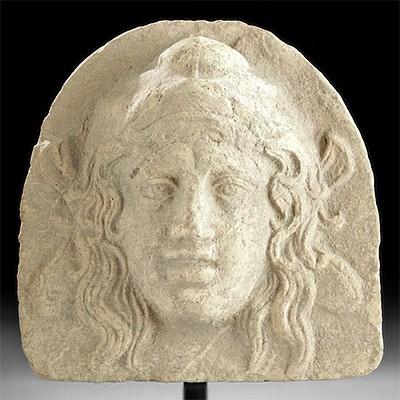Inca Pottery Toad Effigy Vessel
Lot 129a
About Seller
Artemis Gallery
686 S Taylor Ave, Ste 106
Louisville, CO 80027
United States
Selling antiquities, ancient and ethnographic art online since 1993, Artemis Gallery specializes in Classical Antiquities (Egyptian, Greek, Roman, Near Eastern), Asian, Pre-Columbian, African / Tribal / Oceanographic art. Our extensive inventory includes pottery, stone, metal, wood, glass and textil...Read more
Estimate:
$1,500 - $2,000
Absentee vs Live bid
Two ways to bid:
- Leave a max absentee bid and the platform will bid on your behalf up to your maximum bid during the live auction.
- Bid live during the auction and your bids will be submitted real-time to the auctioneer.
Bid Increments
| Price | Bid Increment |
|---|---|
| $0 | $25 |
| $300 | $50 |
| $1,000 | $100 |
| $2,000 | $250 |
| $5,000 | $500 |
| $10,000 | $1,000 |
| $20,000 | $2,500 |
| $50,000 | $5,000 |
| $100,000 | $10,000 |
| $200,000 | $20,000 |
About Auction
By Artemis Gallery
Feb 27, 2020
Set Reminder
2020-02-27 10:00:00
2020-02-27 10:00:00
America/New_York
Bidsquare
Bidsquare : VARIETY SALE | Antiquities & Ethnographic Art
https://www.bidsquare.com/auctions/artemis-gallery/variety-sale-antiquities-ethnographic-art-4920
Around the world & back in time - be amazed at the treasures you will find. Antiquities from Egypt, Greece, Italy and the Near East, Asian, Pre-Columbian, African / Tribal / Oceanic, Native American, Spanish Colonial, Russian Icons, Fine Art, much more! Artemis Gallery info@artemisgallery.com
Around the world & back in time - be amazed at the treasures you will find. Antiquities from Egypt, Greece, Italy and the Near East, Asian, Pre-Columbian, African / Tribal / Oceanic, Native American, Spanish Colonial, Russian Icons, Fine Art, much more! Artemis Gallery info@artemisgallery.com
- Lot Description
Pre-Columbian, Peru, Inca Empire, ca. 1470 to 1532 CE. A hand-built figural vessel in the form of a toad with a flat base, a bulbous body with legs in low relief, a raised head, and a cylindrical spout with a flared rim. The highly burnished vessel is painted with layers of orange and red-orange pigment to mimic the skin color, and the petite black spots that cover most of the body and head are representative of the leathery, bumpy skin texture of a real toad. The amphibious countenance bears incised almond-shaped eyes with elongated outer canthi, a broad nose, and a thin mouth leading to a petite chin. Size: 9.375" L x 7.4" W x 7.7" H (23.8 cm x 18.8 cm x 19.6 cm)
Toads and frogs are common iconographic subjects in Pre-Columbian artistry as their tadpole-to-land-animal life cycle was perceived as a highly symbolic representation of life, death, and rebirth. Some toads were also revered by shamans and medicine men, for their hallucinogenic secretions were often left as tomb offerings to deceased individuals. The Jesuit Bernabe Coco, in his "Historia del Nuevo Mundo" written in the early 1600s, recorded that the common toad (the "hampatu" in the Quechua language) was venerated by local people in the Andes because of its connection to water. Inca art such as the stone of Sayhuite depicts a toad in water basins and near other symbols of water. Given the life-giving properties of water, it seems likely that toads were also associated with fertility and virility.
Provenance: ex-private Hans Juergen Westermann collection, Germany, collected from the 1950s to the 1960s
All items legal to buy/sell under U.S. Statute covering cultural patrimony Code 2600, CHAPTER 14, and are guaranteed to be as described or your money back.
A Certificate of Authenticity will accompany all winning bids.
We ship worldwide and handle all shipping in-house for your convenience.
#153398Professionally repaired from multiple large pieces, with restoration to areas of rim, spout, shoulder, and upper body, and resurfacing with overpainting along new material and break lines. Abrasions to base, body, head, and spout, with fading to original pigmentation, and light encrustations. Nice original pigmentations remains throughout. Old inventory label beneath base.Condition
- Shipping Info
-
All shipping is handled in-house for your convenience. Your invoice from Artemis Gallery will include shipping calculation instructions. If in doubt, please inquire BEFORE bidding for estimated shipping costs for individual items.
-
- Buyer's Premium



 EUR
EUR CAD
CAD AUD
AUD GBP
GBP MXN
MXN HKD
HKD CNY
CNY MYR
MYR SEK
SEK SGD
SGD CHF
CHF THB
THB















